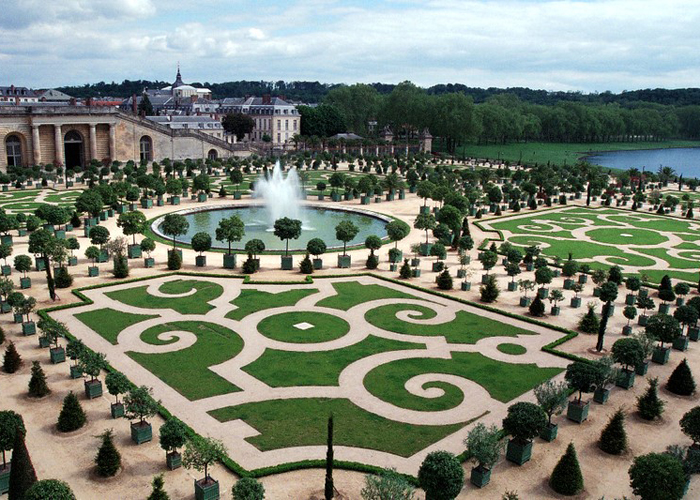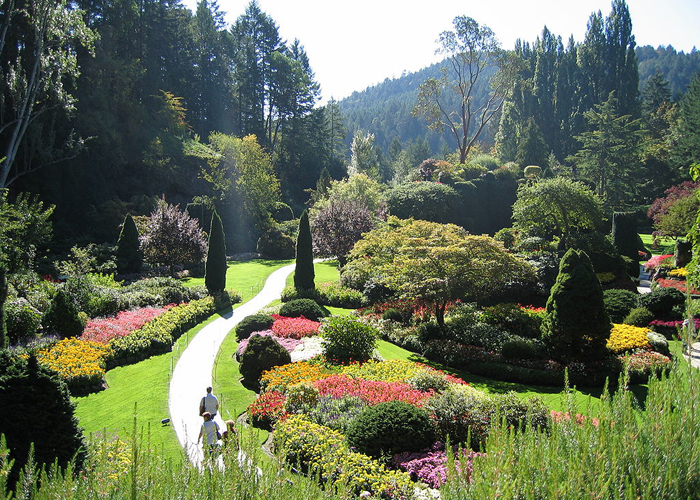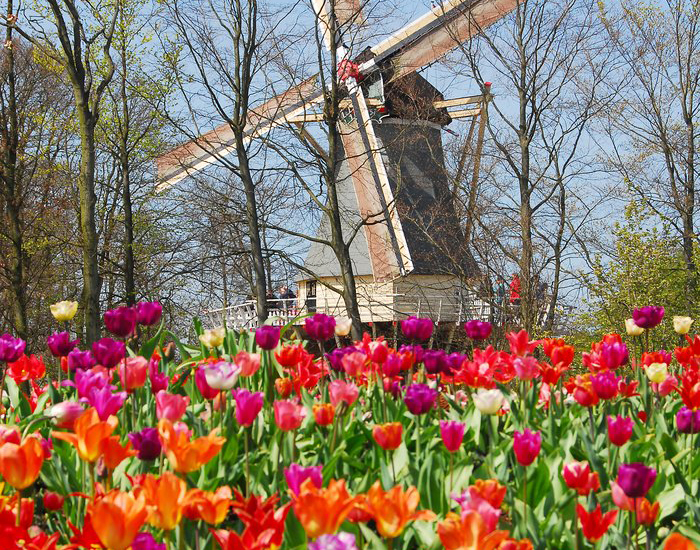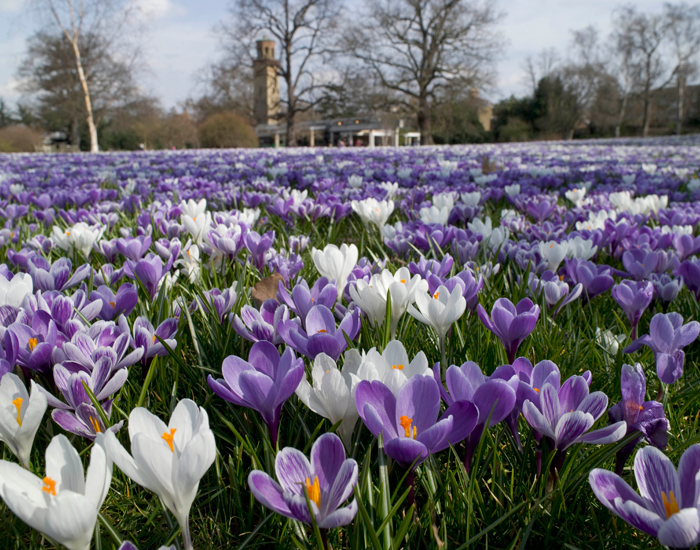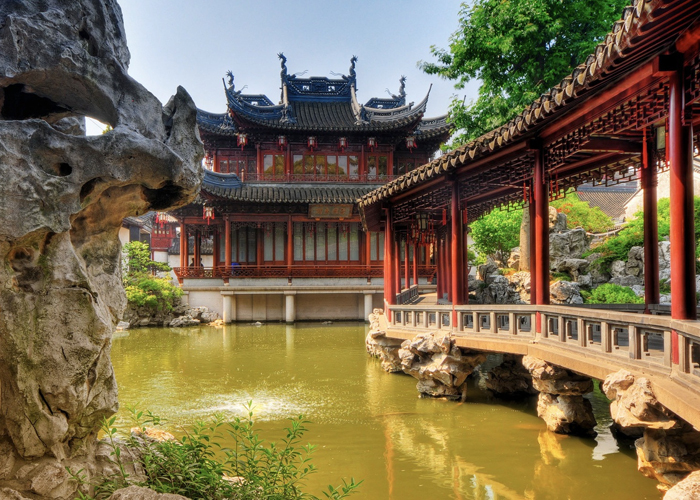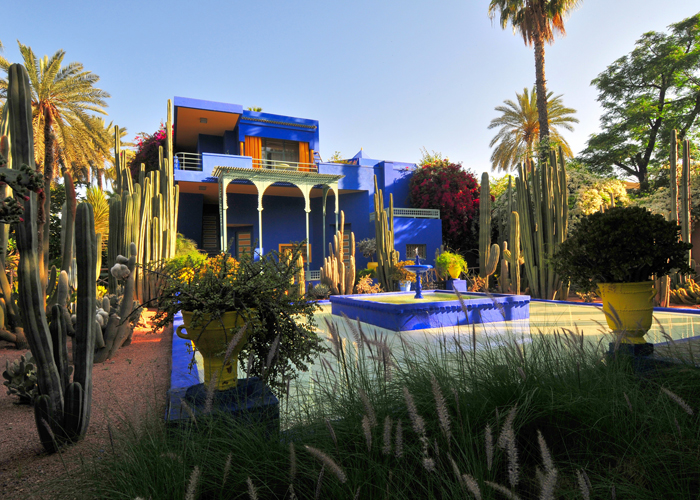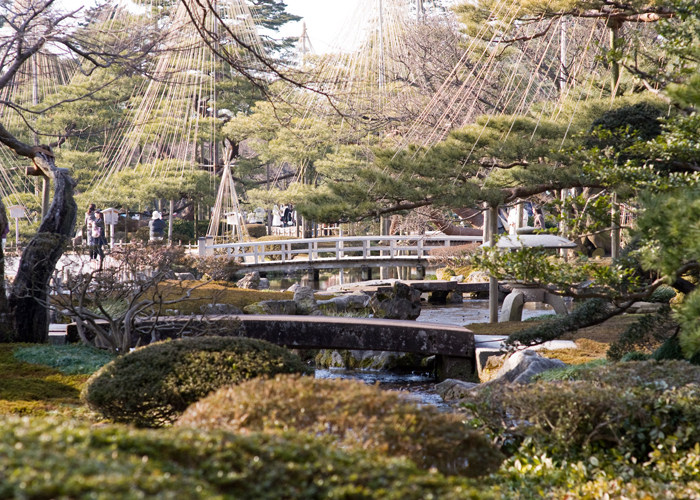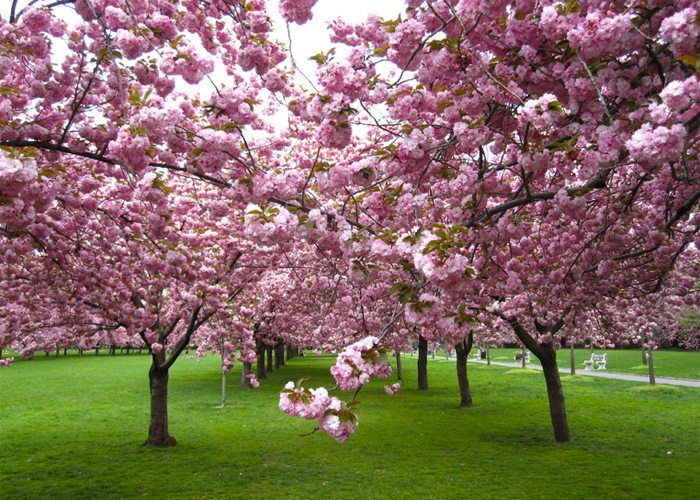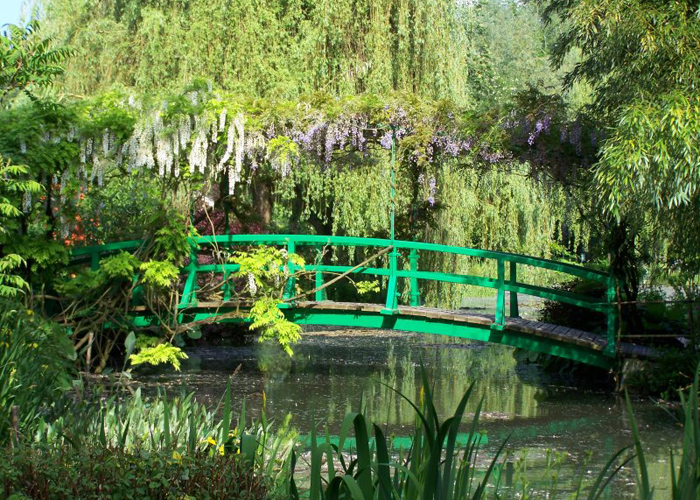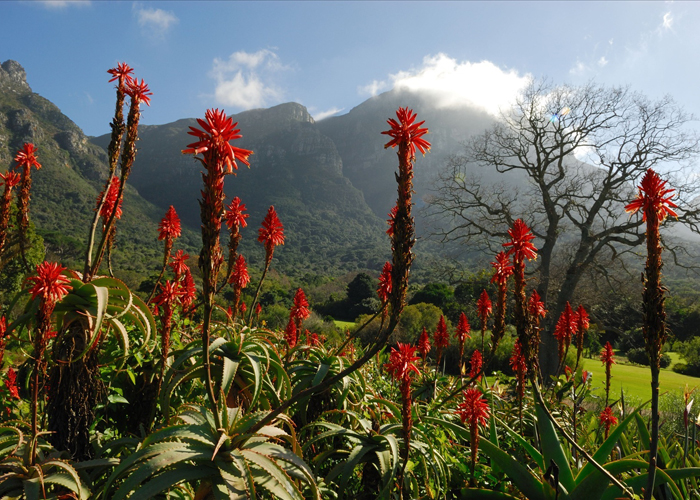1. Chateau Versailles, France
Channel your inner princess and spend an afternoon getting lost among the flowerbeds and immaculate mazes at Versailles’ exquisite royal gardens. Back in 1631, the dazzling palace was a simple hunting lodge built by the French King Louis XIII. But when his son, King Louis XIV took over the thrown he transformed the lodge into an astonishingly lavish palace. In Louis’ opinion his backyard was just as important as his palatial estate so he enlisted the help of Andre Le Notre, one of France’s premier landscape architects to help make his dream oasis a reality.
For 40 years, Le Notre helped Versailles blossom. The earth was shifted, canals were constructed and thousands of labourers worked day and night to transform 800 hectares of rugged land into one of the most breathtaking backyards in the history of man.
The result is simply astounding.
The gardens at Versailles are home to more than 200,000 trees, 210,000 flowers, 5.5 kilometres of canals and more than 50 exquisite fountains, each with their own opulent statues and carvings. There are dozens of mazes and walking trails that Louis built specifically for introspective strolls. It’s no wonder nearly 3 million visitors flock from all over the world to take in the wonders of Versailles and its gorgeous gardens.
Visit en.chateauversailles.fr for more information.
2. Butchart Gardens, Vancouver Island
It was 1904 when Robert Butchart, a pioneer in the burgeoning cement industry, crossed the rugged Canadian landscape with his wife Jennie making the grueling journey from Ontario to Canada’s west coast. Mr. Butchart was a pioneer in the cement industry and opened a limestone quarry on Vancouver Island. As he exhausted limestone deposits, his enterprising wife decided to transform the empty pit into a living piece of art. Bit by bit she soiled and planted the quarry floor and bit by bit it blossomed.
Over a century later Butchart Gardens has grown into one of the most extravagant gardens in the world. In addition to Mrs. Butchart’s original garden, dubbed the Sunken Garden because it’s found at the bottom of a quarry, four more gardens have sprouted up on the Butchart grounds. Passing through a Torii gate in the late spring guests can walk along gentle paths dotted with Himalayan Blue poppies alongside streams and over bridges getting a taste of the Zen life in the Japanese Garden. The Italian Garden features an extravagant star shaped pond surrounded by colourful annuals with a charming frog fountain rising up from the centre. Rub the bronze Tacca statue for good luck as you enter the Mediterranean Garden where you’ll find lush, exotic plants from around the world. And make sure you make time to stop and smell the roses and the Butchart’s fragrant Rose Garden.
Visit butchartgardens.com for more information.
3. Keukenhof Gardens, Netherlands
The largest garden in the world is rooted in competition. The Keukenhof Gardens, also known as the Garden of Europe, was established by the mayor of the small Dutch town of Lisse as a flower exhibition. He invited growers from all of Europe to come and show off their hybrids. The event was a way to beautify Lisse and promote Dutch industry – the Netherlands is the biggest exporter of flowers in the world.
Sixty years Keukehnhof has blossomed into the world’s biggest collection of flowers, with more than 7 million bulbs planted annually. Botanists are sure to find inspiration among the grounds uniquely themed gardens. From the black and white themed Dutch Cow Garden, to the tasty Cookery Garden, to the DIY-inspired Recycling Garden, there’s something for everyone, green thumbs or not.
Famous for the tulips, which typically blossom in mid-April depending on the weather, Kukenhof attracts visitors from all over the world and is favourite among the Dutch Royals.
Visit keukenhof.nl/en for more information.
4. Kew Gardens, London
The Royal Bontanic Gardens, more affectionately referred to as Kew, is home to the world’s largest collection of living plants. A mecca for gardeners from around the globe, Kew is also an international botanical research and education centre home to 700 botanists and scientists.
Established in 1759, there are more than 30,000 different species of plants on the 121-hectare plot of land, just a 30-minute trip from central London. Kew is famous for it’s historic greenhouses. The Bonsai House features an impressive collection of bonsai trees, some dating back 150 years. The Waterlily House is home to a giant pond built in 1852 specifically to showcase to giant Amazon waterlily, which was first encountered by European botanists in South America at the turn of the 19th century.
Guests will have to wait a few years to venture inside the Temperate House, but the wait will surely be worth it. This Victoria glasshouse is the largest of its kind the world and houses a unique collection over 4,000 plants, many of which no longer grow in the wild. It’s currently undergoing a £34.3 million renovation and is scheduled to reopen in 2018.
Visit kew.org for more information.
5. Yuyuan Garden, China
It’s roots were planted by the Pan family, rich Ming Dynasty officials who ruled China in the 16th century, but today this ancient Asian wonder is popular with modern tourists who flock to the tranquil gardens to unplug and unwind.
Located in the Old City of Shanghai, the Yuyuan Garden features glittering pools, lush greenery sprouting from archaic rock, fragrant magnolia, weeping willows and vibrant cherry trees, making it the ultimate peaceful respite from the bustling city that surrounds it. Next to the garden entrance is the Húxīntíng Teahouse, one of the most famous teahouses in China.
6. Jardin Mojorelle, Marrakech, Morrocco
The seeds of the Jardin Majorelle were sown in the mind of French painter Jacques Majorelle. After living all throughout Europe and Egypt, Majorelle moved to Morocco stopping first in Casablanca before trading it for the oasis-city Marrakesh. The colours, streetscapes, sounds and sites inspired many of Majorelle’s art nouveau style paintings.
In 1923 Majorelle bought a parcel of land outside a palm grove in Marrakesh and began what would ultimately become a 40-year project. An amateur botanist and luxurious gardener, he filled his garden with dazzling plants collected on his travels across five continents until his death in 1962.
Filled with exotic plants of all shapes and colours, this vibrant garden is popular among tourists in Morroco who are drawn to its Art Deco décor, sugared fragrance and Moorish charm. Designer Yves St. Laurent loved the space so much he named a nail polish after it.
Visit jardinmajorelle.com for more information.
7. Kenroku-en Garden, Iskikawa, Japan
One of the Three Great Gardens of Japan the Kenroku-en Garden, located in the Japanese city of Kanazawa is an oasis of floral and fauna with distinct, captivating looks for each season making it a hit attraction all year round in the western seaside city.
The name Kenroku-en means “Garden of the Six Sublimities” referring to the spaciousness, seclusion, artificiality, antiquity, abundant water and broadviews, which according to Chinese Landscape theory are the six essential attributes that make up a perfect garden.
With roots dating back to the 1620’s the garden is rich in Japanese history. The ruling Maeda family built it over two centuries as an outer garden for the Kanasawa castle. It was opened to the public in 1871.
The soil is home to Karasaki Pine trees planted hundreds of years ago by the 13th lord Nariyasu as well as ancient structures like the Kaiseki Pagoda and Yūgao-te teahouse. Visitors stroll along lush, calm pathways carved alongside gentle streams and ponds making the experience a truly tranquil one.
8. Brooklyn Botanic Garden, New York
In the heart of trendy Brooklyn, smack dub in the middle of one of the world’s largest urban jungles there’s a 52-acre oasis that makes the hustle and bustle of the Big Apple feel like a world away.
Strolling through the Brooklyn Botanic Garden it’s hard to believe that 150 years ago the grounds were home to an ash dump. The lush green is home to 12,000 different plant species spread across dozens of mini gardens each with their own unique flora and fauna.
The Japanese Hill-and-Pond Garden is the first Japanese garden of its kind in America and features elaborate walking paths, koi ponds, wooden bridges, hills, stone laterns and a Shinto shrine.
The Brooklyn Botanic Garden also boasts the most beautiful collection of cherry trees outside of Japan. Thousands of visitors visit the park in April mesmerized by the garden’s rows of magical blossoming cherry trees. The first cherries were planted in the garden after World War 1, a gift from the Japanese government. Each spring when the trees are in bloom there is a month-long cherry blossom viewing festival called Hanami. The blossom sequence is tracked online on the Cherry Watch page of the BBG website, so visitors can make the most of their visit.
Visit bbg.org for more information.
9. Claude Monet’s Gardens – Giverny, France
Step into one of Claude Monet’s famous watercolour creations with a trip to the gardens that inspired the French painters work.
Longing for the peace and quiet of the countryside, Monet, one of the founders of French Impressionist painting, moved to Giverny in the late 19th century renting a home and two acres of land for his family. He loved the spot so much he eventually bought the property from his landlord and began a lifelong project painting the lush gardens and landscapes that surrounded his home, something he continued until his death in 1926.
Monet would often paint the same scene multiple times capturing the subtle differences in light that changed throughout the seasons meaning many of Monet’s beloved landscapes are very familiar to the art lovers who follow his work.
Each spring more than 30,000 flowers bloom in Monet’s Garden, turning the slice of French countryside into a stunning and fragrant oasis filled speckled with tranquil, reflective ponds and colourful flowers. Only a short distance from Paris it’s a treat for garden and art lovers alike.
10. Kirstenbosch National Botanical Garden, Table Mountain, Cape Town, South Africa
Nestled at the foot of Table Mountain the Kirstenbosch National Botanical Garden is considered by many to be Africa’s most beautiful collection of plant life. In the heart of the Cape Floral Kingdom, which was declared a UNESCO World Heritage Site in 2004, it’s a favourite among hikers who often combine their visits with a trip to the top of South Africa’s famous flat-topped landmark.
Located along the Table Mountain’s eastern slopes, Kirstenbosch was established in 1913 to promote conserve and display the extraordinarily rich and diverse flora of southern Africa and was the first botanic garden in the world devoted to a country’s indigenous flora. The 36-hectare garden is part of a 528 hectare estate that contains protected mountainside forest, plant life, animals and birds.
It’s also the first botanical garden to be located within a UNESCO World Heritage site.
--By Alex Weber

